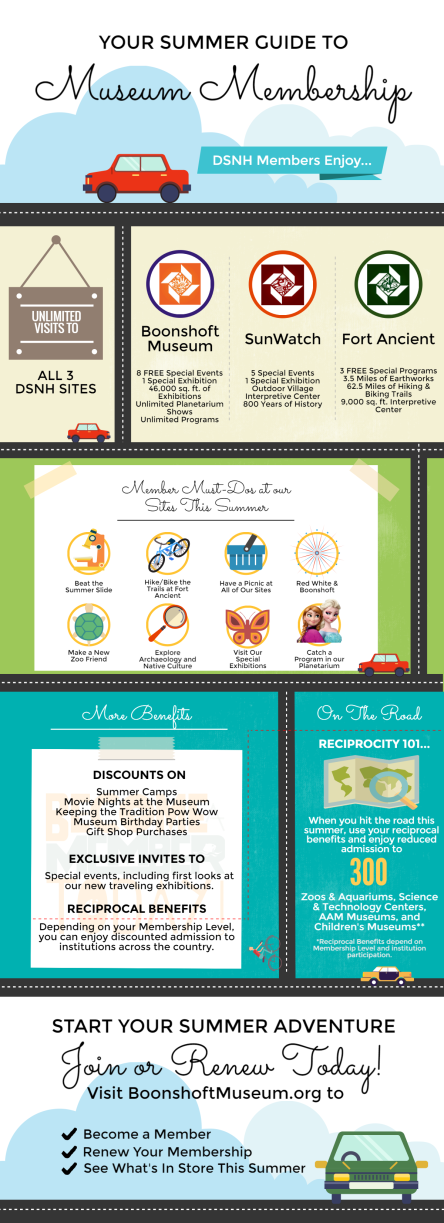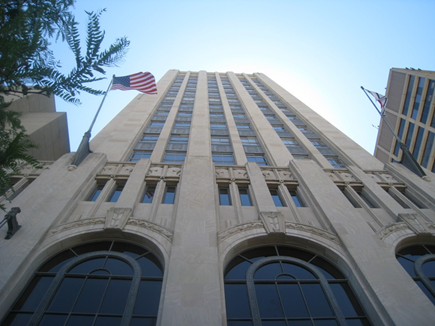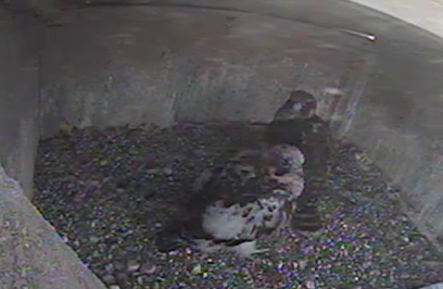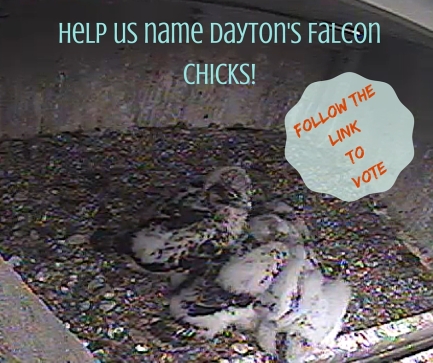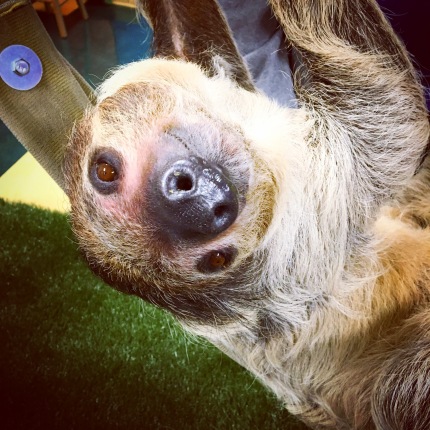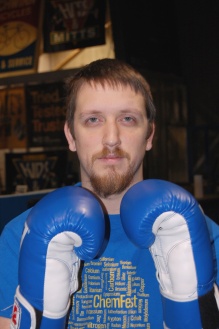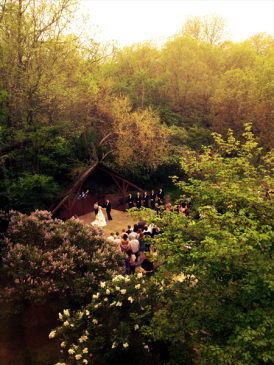 Though it’s not your typical Museum career, our Rentals Manger, Jodi Rettig, certainly has a curious job at the Dayton Society of Natural History. The Boonshoft Museum’s Main Exhibit Hall can be housing dinosaur eggs that are millions of years old one week and then be decorated to the nines for an elegant wedding the next.
Though it’s not your typical Museum career, our Rentals Manger, Jodi Rettig, certainly has a curious job at the Dayton Society of Natural History. The Boonshoft Museum’s Main Exhibit Hall can be housing dinosaur eggs that are millions of years old one week and then be decorated to the nines for an elegant wedding the next.
From laying out schematics to programming personalized slide shows, Jodi uses science and math to be a success at her job, in addition to utilizing Museum technologies in order to create one-of-a-kind events for her clients. Read more about Jodi’s curious career below and then check out some tips she has to create both a special and casual event.
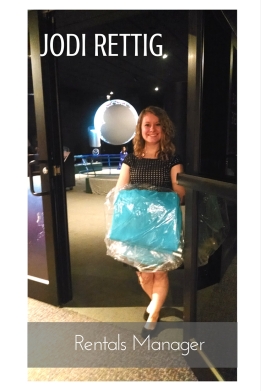 My position as Rentals Manager calls for many different skills, including planning and organizing, working closely with chosen vendors, and communicating with staff from the museum. I schedule tours to show potential clients around the museum, which helps show the museum from a whole new perspective. From using our climbing tower as a place for a band to turning Science On a Sphere into a moonlit area perfect for a bride and groom’s first dance, I truly enjoy making our clients’ happiest days come to life by customizing our spaces.
My position as Rentals Manager calls for many different skills, including planning and organizing, working closely with chosen vendors, and communicating with staff from the museum. I schedule tours to show potential clients around the museum, which helps show the museum from a whole new perspective. From using our climbing tower as a place for a band to turning Science On a Sphere into a moonlit area perfect for a bride and groom’s first dance, I truly enjoy making our clients’ happiest days come to life by customizing our spaces.
We regularly host weddings and corporate events in the Planetarium and use the screen in the Dome as a blank slate for the client to create, and I also love outdoor ceremonies and events in our Amphitheater in the spring and summer. Working with our clients and seeing their event turn into an unforgettable experience is hands-down the most enjoyable part of my job, especially because I visited the Museum as a child. Seeing my clients and their guests enjoy the Museum as much as I do is really fulfilling.
Here are Jodi’s top tips for planning and implementing both formal and casual events:
If you’re planning a wedding, holiday party, fundraising event, or prom, don’t forget to:
Email us or pop by during house of operation. Emailing or stopping by a facility are the best ways to stay in contact with your venue and vendors, especially around the busy wedding/holiday season. Many vendors and venues are dealing with several clients at a time, and the best way for us to keep track of all the details is through e-mail. This allows you and the vendor to have the paperwork needed to make a check list.
Research your vendors. It never hurts to ask about vendors, especially when it comes to choosing just the right DJ, caterer, photographer, and florist. At the Museum, we have worked with many vendors, and with a unique venue like ours, we are able to refer you to vendors that know our space and will best fit your budget.
Utilize your venue. If your event is in a unique space, it also never hurts to ask about using those aspects of your venue. We allow guests to incorporate programs and exhibits into their event quite often and because our spaces are so versatile, the possibilities here are almost endless. Yes, we can bring animals out for your guests. Yes, your guests can use the slide. Yes, we can create a program on our Planetarium, solely for you. Never be afraid to ask!
Navigate Your Guests! Accurate Driving directions are great to have as well as a convenient list of nearby hotels. Contact your venue for a map or driving tips that you can relay to your guests. It can save time and it ensures that everyone has a wonderful commuting experience.
Plan ahead! Avoid waiting until the last minute. It is very easy to do when you are coordinating an entire event and things may slip through the cracks if you aren’t organized. Having a timeline and a “to-do” list are great to have and to pass on to your vendors and venues. At the museum, we will have several staff members working on your event. Whether it is programming your personalized hashtag on our Science On a Sphere, pulling together songs for your custom Planetarium show, or displaying your slideshow over our Tidal Pool exhibit, but we always work from a list of vendor requests, so it is a good idea to get the venue and vendors everything they will need a few weeks in advance.

Wedding in Science On a Sphere

Formal Event in the Education Lobby

Wedding in the Planetarium

Wedding in the Main Exhibit Hall

Fundraising Event on the Museum’s First Floor

Corporate Event in the Main Exhibit Hall
What about birthday parties, family reunions, and anniversaries? If you’re planning one of these events, remember to:
Book it early! It’s always a good idea to call a few months before your big occasion. Though smaller spaces may be more readily available than a full-museum rental, they still book quickly. This is especially something to keep in mind if you have a birthday to celebrate because you may not be as flexible about the date of your rental.
Make use of everything that is offered! At the Museum, we offer admission for all of our guests after your rental. Maximize their experience by passing out our programming schedule for your guests so they can see some of our planetarium shows or participate in a Do Lab program. Our Museum Mascot, Odyssey the Otter, can make his special appearance just for the birthday boy/girl and personal animal programs for your party are available for an additional, but budget-friendly, fee. You can also play music and a slide show for your party guests to see. Make it a moment your guests and birthday boy/girl will always remember!
Give it a theme! Birthday parties with themes work really well for planning invitations and decorations. For example, science, animals, and space themes all work really well at the Museum. The experience your guests will have at the Museum ties in perfectly with these themes.
Ask away! Again, never be afraid to ask questions. If you have an idea in mind, pass it by the venue contact, as we always work to tailor each event to the client’s individual needs.
Manage your guest list closely! Most birthday venues have a guest minimum and a guest maximum. This is for the safety of both the staff and the guests. A headcount of event attendees will also help you plan for what you’ll need to have as far as food, plates, and party favors – which keeps you from overspending and you can stick to your budget!

Animal Program at the Boonshoft Museum

Birthday Guests Cut Their Cake

Guests enjoy their private room.
If you would like to learn more about booking a rental at the Boonshoft Museum or SunWatch Indian Village/Archaeological park, click here. To email Jodi about booking a private event or rental click here.
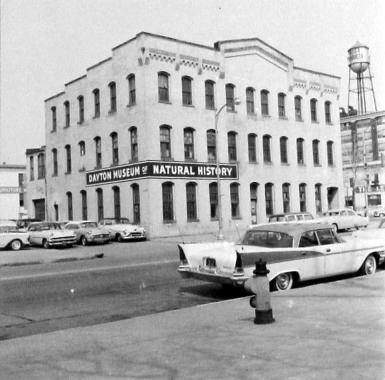
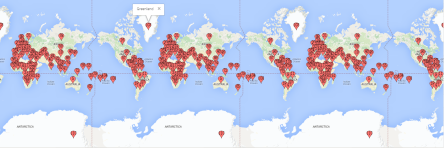






 Though it’s not your typical Museum career, our Rentals Manger, Jodi Rettig, certainly has a curious job at the Dayton Society of Natural History. The Boonshoft Museum’s Main Exhibit Hall can be housing dinosaur eggs that are millions of years old one week and then be decorated to the nines for an elegant wedding the next.
Though it’s not your typical Museum career, our Rentals Manger, Jodi Rettig, certainly has a curious job at the Dayton Society of Natural History. The Boonshoft Museum’s Main Exhibit Hall can be housing dinosaur eggs that are millions of years old one week and then be decorated to the nines for an elegant wedding the next. My position as Rentals Manager calls for many different skills, including planning and organizing, working closely with chosen vendors, and communicating with staff from the museum. I schedule tours to show potential clients around the museum, which helps show the museum from a whole new perspective. From using our climbing tower as a place for a band to turning Science On a Sphere into a moonlit area perfect for a bride and groom’s first dance, I truly enjoy making our clients’ happiest days come to life by customizing our spaces.
My position as Rentals Manager calls for many different skills, including planning and organizing, working closely with chosen vendors, and communicating with staff from the museum. I schedule tours to show potential clients around the museum, which helps show the museum from a whole new perspective. From using our climbing tower as a place for a band to turning Science On a Sphere into a moonlit area perfect for a bride and groom’s first dance, I truly enjoy making our clients’ happiest days come to life by customizing our spaces.











